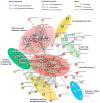Insights into Common Octopus (Octopus vulgaris) Ink Proteome and Bioactive Peptides Using Proteomic Approaches
- PMID: 37103345
- PMCID: PMC10142993
- DOI: 10.3390/md21040206
Insights into Common Octopus (Octopus vulgaris) Ink Proteome and Bioactive Peptides Using Proteomic Approaches
Abstract
The common octopus (Octopus vulgaris) is nowadays the most demanded cephalopod species for human consumption. This species was also postulated for aquaculture diversification to supply its increasing demand in the market worldwide, which only relies on continuously declining field captures. In addition, they serve as model species for biomedical and behavioral studies. Body parts of marine species are usually removed before reaching the final consumer as by-products in order to improve preservation, reduce shipping weight, and increase product quality. These by-products have recently attracted increasing attention due to the discovery of several relevant bioactive compounds. Particularly, the common octopus ink has been described as having antimicrobial and antioxidant properties, among others. In this study, the advanced proteomics discipline was applied to generate a common octopus reference proteome to screen potential bioactive peptides from fishing discards and by-products such as ink. A shotgun proteomics approach by liquid chromatography coupled with tandem mass spectrometry (LC-MS/MS) using an Orbitrap Elite instrument was used to create a reference dataset from octopus ink. A total of 1432 different peptides belonging to 361 non-redundant annotated proteins were identified. The final proteome compilation was investigated by integrated in silico studies, including gene ontology (GO) term enrichment, pathways, and network studies. Different immune functioning proteins involved in the innate immune system, such as ferritin, catalase, proteasome, Cu/Zn superoxide dismutase, calreticulin, disulfide isomerase, heat shock protein, etc., were found in ink protein networks. Additionally, the potential of bioactive peptides from octopus ink was addressed. These bioactive peptides can exert beneficial health properties such as antimicrobial, antioxidant, antihypertensive, and antitumoral properties and are therefore considered lead compounds for developing pharmacological, functional foods or nutraceuticals.
Keywords: by-product; marine natural products; mass spectrometry; protein network; protein-based bioinformatics; shotgun proteomics.
Conflict of interest statement
The authors declare no conflict of interest.
Figures





Similar articles
-
Decoding Octopus Skin Mucus: Impact of Aquarium-Maintenance and Senescence on the Proteome Profile of the Common Octopus (Octopus vulgaris).Int J Mol Sci. 2024 Sep 15;25(18):9953. doi: 10.3390/ijms25189953. Int J Mol Sci. 2024. PMID: 39337441 Free PMC article.
-
Identifying Natural Bioactive Peptides from the Common Octopus (Octopus vulgaris Cuvier, 1797) Skin Mucus By-Products Using Proteogenomic Analysis.Int J Mol Sci. 2023 Apr 12;24(8):7145. doi: 10.3390/ijms24087145. Int J Mol Sci. 2023. PMID: 37108304 Free PMC article.
-
Proteomic characterization of the hemolymph of Octopus vulgaris infected by the protozoan parasite Aggregata octopiana.J Proteomics. 2014 Jun 13;105:151-63. doi: 10.1016/j.jprot.2013.12.008. Epub 2013 Dec 23. J Proteomics. 2014. PMID: 24370682
-
Insights into the Regulation of Algal Proteins and Bioactive Peptides Using Proteomic and Transcriptomic Approaches.Molecules. 2019 May 2;24(9):1708. doi: 10.3390/molecules24091708. Molecules. 2019. PMID: 31052532 Free PMC article. Review.
-
Proteomics of the Human Olfactory Tract.OMICS. 2018 Jan;22(1):77-87. doi: 10.1089/omi.2017.0155. OMICS. 2018. PMID: 29356628 Review.
Cited by
-
Applications of tandem mass spectrometry (MS/MS) in antimicrobial peptides field: Current state and new applications.Heliyon. 2024 Mar 31;10(7):e28484. doi: 10.1016/j.heliyon.2024.e28484. eCollection 2024 Apr 15. Heliyon. 2024. PMID: 38601527 Free PMC article. Review.
-
Decoding Octopus Skin Mucus: Impact of Aquarium-Maintenance and Senescence on the Proteome Profile of the Common Octopus (Octopus vulgaris).Int J Mol Sci. 2024 Sep 15;25(18):9953. doi: 10.3390/ijms25189953. Int J Mol Sci. 2024. PMID: 39337441 Free PMC article.
-
Cardioprotective Peptides from Dry-Cured Ham in Primary Endothelial Cells and Human Plasma: An Omics Approach.Antioxidants (Basel). 2025 Jun 24;14(7):772. doi: 10.3390/antiox14070772. Antioxidants (Basel). 2025. PMID: 40722877 Free PMC article.
References
-
- Vaz-Pires P., Seixas P., Barbosa A. Aquaculture Potential of the Common Octopus (Octopus vulgaris Cuvier, 1797): A Review. Aquaculture. 2004;238:221–238. doi: 10.1016/j.aquaculture.2004.05.018. - DOI
-
- Prado-Álvarez M., Dios S., García-Fernández P., Tur R., Hachero-Cruzado I., Domingues P., Almansa E., Varó I., Gestal C. De Novo Transcriptome Reconstruction in Aquacultured Early Life Stages of the Cephalopod Octopus vulgaris. Sci. Data. 2022;9:609. doi: 10.1038/s41597-022-01735-2. - DOI - PMC - PubMed
MeSH terms
Substances
Grants and funding
LinkOut - more resources
Full Text Sources
Research Materials

